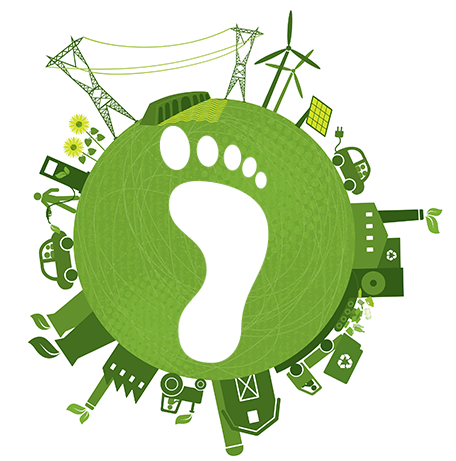If you really want to reduce your carbon footprint, have fewer kids and ditch your car…!
Carbon footprint is the amount of carbon dioxide released into the atmosphere as a result of the activities of a particular individual, organization, or community.
The most common way to reduce the carbon footprint of humans is to Reduce, Reuse, Recycle, Refuse. In manufacturing this can be done by recycling the packing materials, by selling the obsolete inventory of one industry to the industry who is looking to buy unused items at lesser price to become competitive. Nothing should be disposed off into the soil, all the ferrous materials which are prone to degrade or oxidize with time should be sold as early as possible at reduced price.
This can also be done by using reusable items such as thermoses for daily coffee or plastic containers for water and other cold beverages rather than disposable ones. If that option isn’t available, it is best to properly recycle the disposable items after use. When one household recycles at least half of their household waste, they can save 1.2 tons of carbon dioxide annually.
Another easy option is to drive less. By walking or biking to the destination rather than driving, not only is a person going to save money on gas, but they will be burning less fuel and releasing fewer emissions into the atmosphere. However, if walking is not an option, one can look into carpooling or mass transportation options in their area.
Choice of diet is a major influence on a person’s carbon footprint. Animal sources of protein (especially red meat), rice (typically produced in high methane-emitting paddies), foods transported long distance and/or via fuel-inefficient transport (e.g., highly perishable produce flown long distance) and heavily processed and packaged foods are among the major contributors to a high carbon diet.
Finally, throwing food out not only adds its associated carbon emissions to a person or household’s footprint, it adds the emissions of transporting the wasted food to the garbage dump and the emissions of food decomposition, mostly in the form of the highly potent greenhouse gas, methane.
The carbon handprint movement emphasizes individual forms of carbon offsetting, like using more public transportation or planting trees in deforested regions, to reduce one’s carbon footprint and increase their “handprint.”
Furthermore, the carbon footprint in the food industry can be reduced by optimizing the supply chain. A life cycle or supply chain carbon footprint study can provide useful data which will help the business to identify critical areas for improvement and provides a focus. Such studies also demonstrate a company’s commitment to reducing carbon footprint now ahead of other competitors as well as preparing companies for potential regulation. In addition to increased market advantage and differentiation eco-efficiency can also help to reduce costs where alternative energy systems are implemented.

The most significant way individuals could mitigate their own carbon footprint is to have fewer children, followed by living without a vehicle, forgoing air travel and adopting a plant-based diet.
Having one fewer pair of small human feet padding around your home can help the environment, at least those were the findings of a study published in the journal Environmental Research Letters. Looking at 39 peer-reviewed articles and governmental reports, the researchers determined that the best way to reduce your personal carbon emissions was to have one fewer child.
In reality though, shrinking one’s carbon footprint is difficult, and conscious choices have to be made to do it.
Researchers are aware of this, advocating that textbooks shift away from advocating for the low-impact solutions, like plastic bag reduction, and put forth possible solutions that are more radical, or at the very least, will have a bigger impact.
“Though adolescents poised to establish lifelong patterns are an important target group for promoting high-impact actions, we find that ten high school science textbooks from Canada largely fail to mention [high-impact] actions (they account for 4 percent of their recommended actions), instead focusing on incremental changes with much smaller potential emissions reductions.”
Of course, high impact and low impact choices can vary depending on where a person lives, something else the study points out.
For instance, switching from a gasoline automobile to an electric car still emits the equivalent of 1.15 tonnes of CO2 a year, but this number can go up if the electricity used in your area doesn’t rely heavily on renewable sources of energy.
“We provide mean values for our recommended actions,” the researchers write, “but we do not suggest that these are firm figures universally representative of each action, but instead best estimates.”
Still, taking bigger swings to help the planet may have enough of a spillover effect to save it, the researchers believe. At least until we’ve all gone vegan and are walking everywhere.
Take an action today to help the environment.

